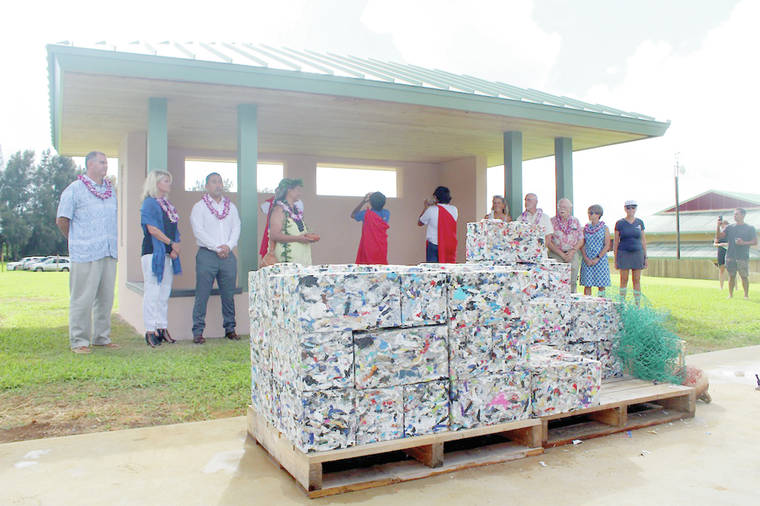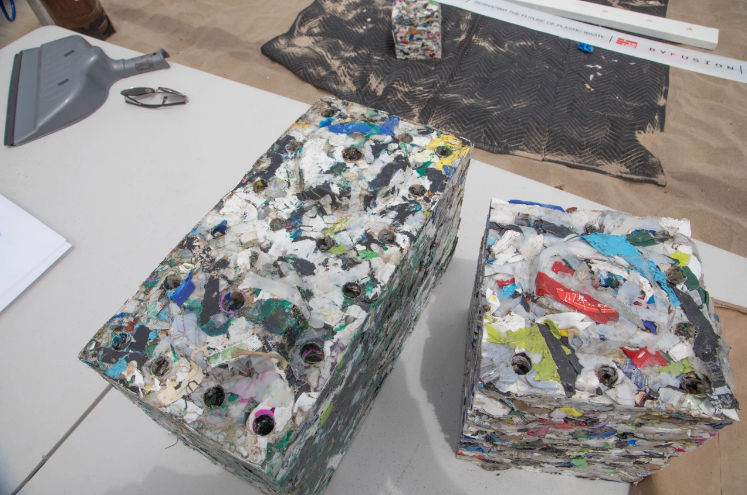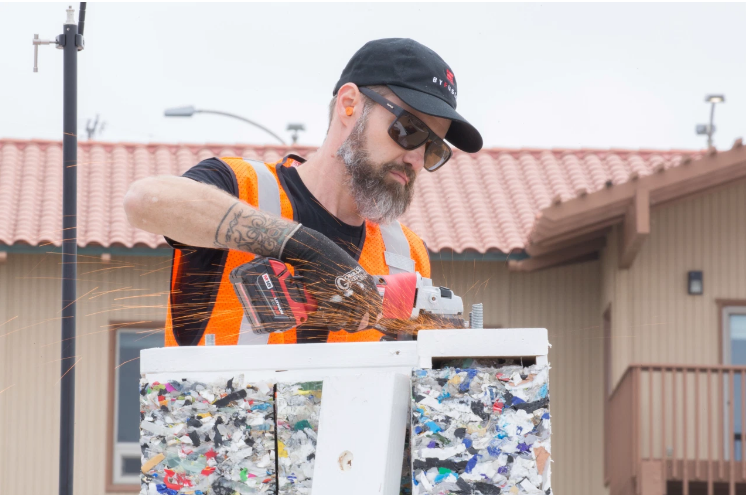This natural building blog occasionally features information about solutions to global pollution problems and this post is about a building block that is made entirely out of recycled plastic. The small community where I live in New Mexico stopped recycling plastic about a year ago, so now it has all been going to the land fill. Yuck… with the oceans and countryside overflowing with plastic particles, we have got to find a way beyond this, and I feel that local reuse of recycled materials is the best solution. A New Zealand-based company named ByFusion is now selling equipment that can be used on a relatively small scale to do just that.
There’s an athletic pavilion on Kauai, Hawaii made out of plastic marine debris and plastic household waste using blocks that resemble oversized Lego pieces. The debris that was once cluttering shorelines and endangering sea life is providing shade for athletes and onlookers at Island School. The blocks form the walls of the pavilion, and the spaces in between are filled with traditional building materials like rebar, stucco and trusses. The building is about 20 feet in length and is situated by the school’s soccer field.
Each block is made out of shredded, cleaned plastic waste compressed into a solid rectangle. They’re touted as a cheaper form of construction because they’re lighter and require fewer materials for building. Stucco covers the plastic blocks, sealing them and the gasses they produce should they decompose.
Carl Berg, senior science adviser for Surfrider Kauai, says the long-term goal is to bring a ByFusion facility to Hawaii. That would bring manufacturing of the blocks closer to home and present a real potential for recycling marine debris in the state.
You can read more about this at www.thegardenisland.com
The lifeguard tower in Manhattan Beach, California was erected as part of the World Oceans Day activities. The structure was built with bricks made from discarded plastic. While most recycled plastic products require a specific chemical makeup, the ByFusion bricks can be made with any mix of recyclable plastics — Nos. 1 through 7 — except for polystyrene. They don’t need to be pre-washed or sorted, according to company literature. And these “ByBlocks” are stronger than cinder blocks and can be similarly covered with paneling or stucco.
A machine dubbed The Blocker is responsible for turning the plastic debris into construction material. It shreds the plastic then uses “super-heated” water and compression to make the ByBlocks. “The retail prices will be comparable to common hollow cinder blocks but only produce a fraction of the greenhouse gases,” Kujawa said. There are no chemicals or adhesives added in the process.
Kujawa said the company is currently talking to potential manufacturers of the machines in the United States and hopes to have some in use soon. Customers are expected to be recycling centers, waste management facilities and municipalities, she said.
You can read more about this at www.dailybreeze.com

Am I correct to assume that the off gassing of the plastic is mostly a product of UV degradation and that stucco would effectively block that process before it happens?
As far as I know, that is true.
Is there an operating facility on line now?
You might ask the manufacturer of the equipment this question: https://www.byfusion.com/contact/
They are twice as good as normal hollow blocks.
https://www.hindawi.com/journals/amse/2017/9432145/tab3/
“Stucco covers the plastic blocks, sealing them and the gasses they produce should they decompose.”
They must be joking. I thought they had washed the plastic before making it into blocks? Then how ‘should’ they ever decompose?
And if you think stucco has gas blocking properties, think again…
This is such a great idea. I wonder if this plastic could be pressed into long, Lincoln Log dimensions?
Besides stucco, using concrete, are there other plaster types that would prevent off-gassing, especially into living spaces?
Good questions… I suppose that Magnesium Oxide cement could be used to seal the plastic, although it is quite expensive.
Really interesting what is the price range and what do you see in the future getting down to an individual any of the purchase it and use it?
They say they expect the blocks to sell for something equivalent to concrete blocks, and they hope that the technology will spread for them to become locally available.
What is the estimated cost of the Machines. And how much plastic does it to make a single block. Or how many tons per day of plastic would it be needed to produce say 1000 block. What is the weight of a block?. Is there anything else of interest that you can share? Is it an approved building material?
You should ask the manufacturer these questions: https://www.byfusion.com/blocker/
Here is a Data Sheet:
https://www.byfusion.com/wp-content/uploads/2021/01/ByBlock%C2%AE-Product-Data-Sheet_2021.3-1.pdf
Am I reading correctly that these have an R-value of 1.14 per inch? (pg2)